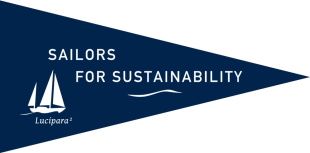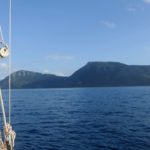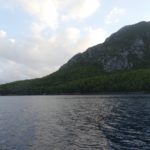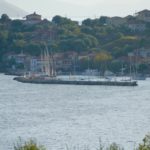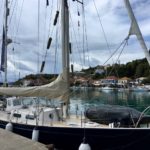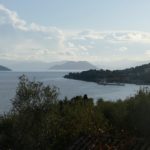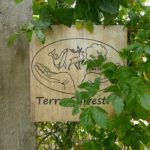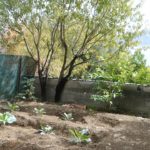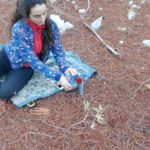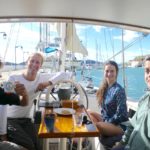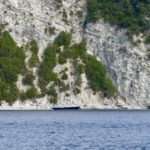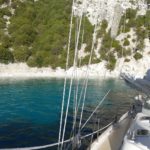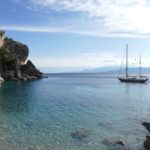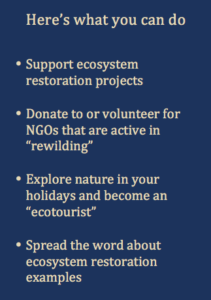Rewilding Kalamos (GRC)
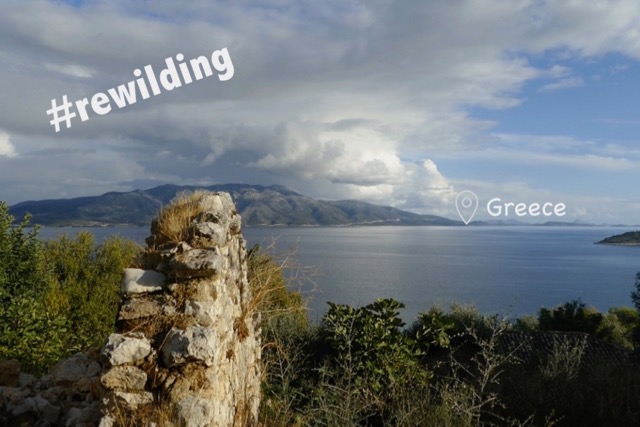
On the Greek island of Kalamos, we learn about rewilding. We are inspired by the way this form of ecosystem regeneration balances natural and human needs.
Contributes to achieving the following UN Sustainable Development Goals:
“Do you see that dark cloud approaching?” Ivar asks. “We better wait outside the port in case it hails strong winds. There is plenty of room to swing here.” Moments later, the forces of nature are released. Rain and wind are raging over us. In the gusts our boat lists greatly, even without sail. Only fifteen minutes later, it is all over and we enter the small harbour of the Greek island of Kalamos just as darkness falls.
A guy with a torchlight kindly helps us to moor our boat. His name is George and after we’re safely moored he suggests that we have dinner in his tavern. Not much later we enjoy his homemade, local dishes. Assuming that he is also the harbourmaster, we ask him about mooring fees. With a smile, George answers that the harbourmaster left the island many years ago. He runs the tavern and only helps the boats with mooring. Everyone can use the harbour for free.
The contrast with the neighbouring island of Lefkas can hardly be greater. That island is a popular holiday destination with bars, restaurants and souvenir shops everywhere; Kalamos is a green oasis in the Ionian Sea and barely cultivated. The tranquillity and absence of a harbourmaster in the middle of a beautiful sailing area intrigue us. Why is it not busier here?
Where is Everyone?
We meet Ted Karfakis. He was born and raised in Kalamos and returned here after years abroad. He tells us that the island once had more than 2,000 inhabitants. But after an earthquake in 1953 and political upheaval, people started to leave. The other village on the coast was completely deserted and is now an overgrown collection of ruins. Young people from elsewhere on the island also moved to the mainland. There was no work and facilities became scarce. Today only slightly more than 200 people live there. “The harbourmaster stopped a few years ago, but nobody wants to take over. There is no regular ferry service. So if you want to go to the mainland or need to transport goods, you always have to arrange something” Ted explains.
“If everyone else leaves, why did you come back?” we ask Ted. He answers cryptically: “A combination of childhood memories and my current mission made me return.” We want to know what he means. “In the United Kingdom I studied ecology and for many years I worked in the field of biological conservation, ecology and on related issues worldwide. A special form of ecosystem regeneration inspired me: rewilding. Such a thing would also be possible here.” Noticing our questioning eyes, Ted proposes to explain it to us in the office of his organization Terra Sylvestris.
Ecosystem regeneration American style
After a climb through the steep streets of the hilly village we arrive at the edge of the forest. Ted’s house has been transformed into the head office of his organization. He shows us a video about the reintroduction of animal and plant species in areas where they originally occurred. We learn about the successful reintroduction of the wolf in Yellowstone National Park. The wolves keep the deer population in check. The deer have since avoided plains and valleys, where they are easy prey for the wolves. This allows the vegetation to recover there. Different tree species return, which attracts birds and beavers. This also means that the soil erosion decreases, the water in the rivers becomes clearer and fish return. This chain reaction brings the ecosystem back into balance and increases biodiversity.
Ted sees the enthusiasm in our eyes. “Inspiring, isn’t it? I think Kalamos would be an excellent place for rewilding, too. Parts of the island are already overgrown, but still a lot needs to be done to restore the island to its original state.” At the same time, he sees opportunities for the local population. “Eco-tourists who come to visit our unique nature could provide much-needed employment.”
A Good Starting Point
Ted talks passionately about his island’s natural beauty. “Our mountainous island is covered by pine forest. The tall trees allow shrubs to grow in their shade. These conditions in combination with dead wood from fallen trees provide for a plethora of different trees, plants and animals, such as the golden eagle. An international bird conservation organization, BirdLife International, considers the area as one of the most important bird areas in Greece.”
Kalamos is not only rich in biodiversity on land. Ted explains that it is special underwater, too. “Posidonia, a rare type of seagrass, grows in the waters around the island. It is not only very important for healthy water management, but also provides important habitats and breeding grounds for several species of fish of economic importance, like the sardine. This in turn attracts whales and dolphins and possibly even the endangered Mediterranean monk seal.”
Kalamos’ natural beauty has led to some protection. Kalamos is in the middle of a marine Natura 2000 site, a designated nature reserve. Yet such status is not sufficient to guarantee successful nature protection, as we soon find out.
Better Protection Instead of Commercial Exploitation
We learn that commercial interests in the region are strong, making rewilding no easy task. Ted highlights that the Greek government decided a few years ago to declare most of the area around Kalamos suitable for the development of industrial aquaculture, or fish farming. There are already some fish farms in place and Ted explains that they pollute the water and destroy the posidonia. As this leads to a decrease in marine biodiversity and natural fish stocks, Ted is not alone in opposing the fish farms: “The local fishermen are an important ally of us in this fight.”
Kalamos is also under pressure from the wind farming industry, which is backed by the central government. The locals oppose it, according to Ted. The proposed sites of the wind turbines are important for birds, so he would prefer to rewild them instead. To achieve that, he supports the island and surrounding area being elevated to a higher status of nature protection. “Only then, nature will be protected adequately and we can begin to reintroduce disappeared species.”
Balancing Rewilding with Human Needs
We wonder how a rewilded Kalamos would differ from the island that we see today and how it would affect the local population. Ted envisages the island’s inhabitants to adopt more sustainable ways of living: “We now live mostly off tourism, like visiting sailboats. If the island is rewilded, we can offer eco-tourism, such as wildlife spotting, bird watching, snorkelling, and hiking.”
He also sees a future for the fishermen. “If they use sustainable fishing methods, such as line fishing, there is room for them, too.” And as there are hardly any farmers left, Ted proposes that the locals grow some of their own food using agroforestry and permaculture techniques. His garden functions as a model. “I have planted various edible plants and fruit-bearing trees, mainly for demonstration purposes to show which foods we could grow ourselves.”
Once rewilded, the island would be covered in vegetation and the sea would be teeming with life again, as it was 60 years ago. To achieve his goal, Ted founded Terra Sylvestris, which stands for “land of the forest”. The organization is committed to protecting the island and the surrounding waters. “I’m running the organisation with the help of volunteers. My house functions as a biological field station. It provides housing for volunteers and is an educational and discussion center. We raise awareness for the protection of our ecosystems and try to find solutions to the challenges we face.”
Field Research
Ted knows that there are various rare species of animals and plants to be found on the island. Yet he realizes that his knowledge alone is not enough to convince the Greek government to protect it. “We have to prove scientifically that this is a special area,” Ted continues. “That’s why we do a lot of field work.”
The next day, we participate in field research with Ana and Thomas, volunteers at Terra Sylvestris. They try to prove the existence of rare birds and take us to the forest. After a hike deep into the thicket, we arrive at a clearing where Ana prepares the equipment to records bird sounds. “Every bird sings its own song. With the help of a computer program we can show exactly which birds there were,” she whispers. For half an hour we sit in absolute silence next to the recorder. With every bird we hear, we ask ourselves: is this a rare one, or a just an ordinary finch?
The next day during coffee on the boat, Ted explains that their research is not only focused on birds. “We try to show with aerial photographs where Posidonia is growing.” Another type of research focuses on endangered marine fauna. “It would really boost our efforts to get protected status if we could prove the existence of rare marine species here.” At that very moment, Ted has an idea. “You plan to sail tomorrow, right? Can you help us to monitor the beach of an uninhabited island nearby?” “Of course!” we reply, pleased that we can make a small contribution.
Giving Back to Nature
Ted has taught us a valuable lesson: where people retreat and nature gets space again, something beautiful can happen. Biodiversity can recover, more CO2 is stored in forests and soils and ecotourism can generate income. This way a new balance can be found between human needs and nature conservation. Which area will follow?
Related Sustainable Solutions

Restoring Mangroves (VCT)
On Union Island, mangrove restoration has led to increased biodiversity, better coastal protection, and more economic activity.

Wildlife Rescue (SUR)
In Suriname, we meet an organization that rescues wildlife. How does that also help our own survival?

Sea Forests (NAM)
In South Africa and Namibia, we learn about the importance of current and future sea forests. How can they help humanity become more sustainable?

Coral Gardening (PYF)
In French Polynesia we see the beauty of coral reefs, but these important ecosystems are under threat. Fortunately, it’s not too late to save them.

Shark Protection (PYF)
French Polynesia is saving sharks with the largest shark sanctuary in the world. These top predators are vital in keeping reefs and oceans healthy.

A Farm That Restores Nature (CHL)
The Chilean farm Alihuen combines organic farming and tourist education to restore local flora and fauna on former grasslands.

Cleverly Fighting Plastic Pollution (CHL)
Chilean company Algramo uses clever, reusable packaging to reduce plastic waste and save customers money.

Investing in Nature (CHL)
Chilean Patagonia thanks its pristine wilderness to successful conservation efforts. Among them Tompkins Conservation, a remarkable, private initiative.

Artificial Reefs (CPV)
In Cape Verde and Brazil we learn how man-made structures can help to restore underwater ecosystems.

Saving Sea Turtles (CPV)
On the Cape Verdian island of Sal, we meet an organisation that saves sea turtles. We learn how biodiversity can be increased and damaged ecosystems restored while working together with the tourism industry.

Rewilding (GRC)
On the Greek island of Kalamos, we learn about rewilding. We are inspired by the way this form of ecosystem regeneration balances natural and human needs.

Reforestation on Steroids (ITA)
Reforestation helps to fight climate change, drought and fires. Innovations like the COCOON support young trees and accelerate the creation of new forests.

Creative with Cork (PRT)
In Portugal we learn all about the environmental and social sustainability aspects of cork. Time to get more creative with this remarkable natural material!
